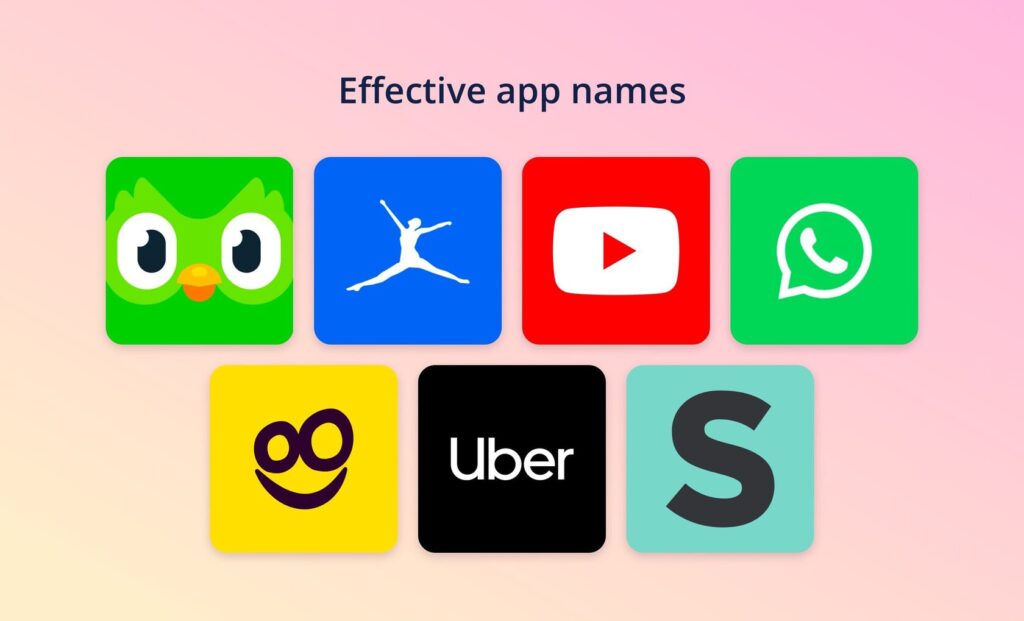The app names are perhaps the most important part of the brand strategy. It should be chosen carefully and wisely because it will be with you throughout the product’s lifecycle. How to name an app to make it memorable, able to overcome language barriers, and, at the same time, unique? It is where the complexity lies. It’s such a seemingly short and simple element, but you can spend a lot of hours making it.
There are currently over 5 million apps published on the Apple Store and Google Play combined. Creating something truly unique is getting harder every day. While brainstorming, in addition to being inspired by the success stories of big brands like Google or Evernote, you should also stick to conventional strategies like keyword and market research and professional tips.
While there are examples of successful rebrandings, such as Facebook becoming Meta, it might not go smoothly for everyone. Therefore, you should choose the name appropriately from the very beginning.
Table of Contents
Why Does Your App Name Really Matter?
The name is the core of any app. A careful approach to how to name apps is essential for several reasons:
- Along with the icon, this element is shown wherever your product can be mentioned: tops, lists, search results, news of the week, and so on.
- Since the maximum number of users can see it, it should be attractive enough for people to download your product. Don’t expect that at least half of them will want to read the full description of your game or app.
- For ranking algorithms, the title has the highest weight, so in addition to the app name itself, it should also include a relevant keyword.
- The best names for apps convey the essence of the product. After reading them, users immediately understand what they will receive after downloading. Therefore, it is important to come up with not only a catchy but also a meaningful name.
The importance of the title cannot be overestimated. It has the highest weight both for app stores’ algorithms and for users. A perfect name paired with a cool icon can entice people to download your product without even visiting your page.
For iOS developers, mastering app naming is especially crucial because, on the Apple Store, you can publish multiple IAPs with unique names that are ranked separately from the main item. To learn more about optimizing IAPs, read our article on “How Do Apps Get Popular.”
How to Come Up With Cool App Names?
We have come to perhaps the most challenging part of the naming applications process. Fortunately, in addition to being creative, dry mobile app analytics will help you with this task, giving you an accurate and in-depth look at the most popular titles. You can identify patterns and trends that brought a particular product to the top.
Keyword research
Creating cool app names should be based on deep keyword research. At this stage, you should find out what words, phrases, and terms your potential clients use to search for similar products. Be sure to check out the iOS and Android app name suggestions to find “related” keywords. It is important to get a list of terms from different categories.
The thing is, the phrases that most accurately describe or associate with your app (for example, dating apps are directly related to “dating”) are very popular. They are high-frequency and extremely competitive, which means you need to use other words that are not as competitive but can also be related to your product. For example, in dating app titles, you can also include the words “love,” “relationship,” or “chat.”
Market research
Market research involves collecting information about competitors: what they call their products, what trends exist in your category, how they “play” with words, and so on. It will give you fantastic app name ideas, as well as help to identify patterns that are most common for similar services to yours. You don’t want to stand out too much from the competition, which can alienate customers.
Market research is also important to avoid name overlap. Some developers wonder, “Can two apps have the same name?” If your product ID is unique, Google Play will have no problem with this. App Store moderators remove apps with the same name, even from different categories. However, naming your application by an already existing name is a bad idea.
Users are unlikely to want to figure out which of two applications with similar titles is better; they just prefer to find something else. So be sure to check if the selected app names are available or if someone already has such titles.

Determine your key features
As we have said, you need to consider your product’s essence when choosing an app name, meaning that it should reflect its main idea, goal, mission, or feature. Take Snapchat, for example. By its name, you can guess that with it, you can take pictures and send them to your friends.
The SoundCloud title features a combination of music and cloud service. It is essential to come up with such a headline, hearing or reading that users will immediately understand what it is for. Given a huge selection of a wide variety of apps, potential customers are unlikely to puzzle over what the name means and read the description; most likely, they will simply opt for a more understandable product.
Play with words or use generators
Usually, a play on words is better remembered. To search for catchy names for apps, you can make a list of the main functions of your application, underline in sentences those words that most accurately and concisely reflect the essence, look for synonyms and even slang words, add suffixes or prefixes to them, etc. This way, you can find words that you can put together to get a new, deeper meaning.
You can also use generators to find the perfect name. Use the collected keywords and paste them into one of these programs. You will receive several options that you can use exactly as they are made or as the basis for your own idea.
Ideas for App Names
Building a name that can compete with the big players in the long run is no easy task. You will need to use it not only for publishing in app stores but also for further promotion. If you want to learn more about the latter, read the article from our experts, “How to Market an App.” Here are a few useful app name ideas and tips that you should keep in mind while working on the name:
- Be short and concise. Although app stores give you 30 characters per title, don’t try to use them all. Short names are easy to remember, can be typed quickly, and can be shared with friends.
- Connect with people’s emotions. Imagine a typical situation where consumers will use your app and think about what emotions they might experience.
- If you already have a website or blog, you’ll want to align it with the name of your mobile product.
- Make a choice in favor of action words. This way, you can tell what your app can be used for.
- Obvious options are not always bad. You will be surprised how many simple words are available.
- Make intentional typos in words or skip vowels.
- Look for options in other languages, such as Latin or Chinese.
You need a fair amount of creativity to use all these tips to the maximum. Have a brainstorming session and ask the whole team to join and “throw in” the ideas that come to their minds.
Best Names for Apps: Examples
The list of catchy app names includes products that have already achieved success. Their progress depends not only on the title but also on other app page elements, as well as competent SEO and ASO strategies and, of course, the app’s quality. However, a fantastic title can really attract a huge number of users. Here are just a few examples of trending apps that are worthy of your attention:
- Duolingo. Its name combines the Latin words “two” and “language,” which perfectly reflects the product’s essence. Based on this idea, Instagram and Pinterest were also invented.
- MyFitnessPal. The developers aimed to create not just a fitness app but a pocket coach who can be perceived as a friend, “pal.” PayPal and GreenPal pursued the same idea.
- YouTube. Marketers have used a capital letter within a word to separate the two semantic elements. Similar examples are WhatsApp and ooVoo.
- Foodies. Adding melodic sounds to a familiar word makes it more memorable. The same idea underlies such catchy titles as Smarty and Phonto.
- Uber. This short, capacious word is taken from German. It contains sounds found in most languages, while in itself, it is pretty showy. Similar examples are Tinder and Tor.
These examples follow the best naming requirements: They are short, catchy, and unique.
How To Name An App: Pro Tips for Creating a Top-Notch Name
With the name, first of all, but also other essential app page elements, you sell your product. The brand name is what users will see and use most often in the app stores, so you should use all methods and techniques that work when choosing it.
Firstly, good brand strategy development cannot be done without market research. You need to know why your main competitors are so attractive to the target audience, what titles and keywords they use, and which trends are hot right now. You need to know who you are competing with and who you want to attract to be able to create the perfect name.
Secondly, you should write down all effective approaches on how to name an app. Describe the core features of your product, pick up synonyms, look into foreign dictionaries, play with words, use associations and consonances, and so on. Create a few good options and try them out with a focus group to find the best one.
Now, the most important thing. Whatever cool name you choose and no matter how carefully thought out your marketing strategy is, everything will be useless if the quality of your product is not at the highest level.




